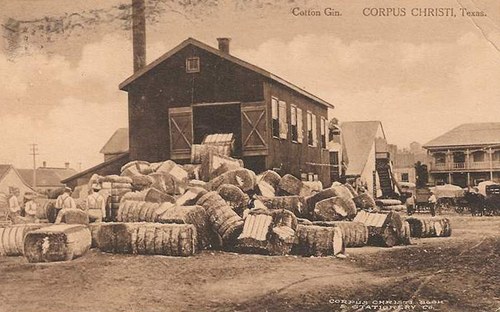| |
Baled in a Bale
by Mike Cox | |
Late
summer and early fall is cotton ginning time
in Texas.
Depending on a growing area’s average
temperatures, which of course vary from south to north across the state, the process
of transforming boles to bales starts as early as July and extends into October
each year.
Every wonder how removing seeds from the fiber came to be called
ginning? According to the Burton Cotton Gin Museum’s web site, after Eli Whitney
invented the machine that transformed the industry in 1793, it came to be called
“The Little Cotton Engine.” Soon, “engine” got shortened to “gin” and a new noun
entered the language.
Though most of the ginning is done by brainless machinery,
the industry’s human element has developed a colorful folklore with a range of
subsets. But no ginning story can top the occasional tale of a body in a bale.
|
 |
I first ran onto
this folklore strain in 2004, when I found a 1909 story published by an Erath
County newspaper in which the solution to a missing child case was reported.
The previous fall, the newspaper said, a two-year-old boy had disappeared without
a trace. He had last been seen playing near a cotton gin. The following spring,
the toddler turned up in England – dead in a bale of fine Texas
cotton.
Recently, I got an email from 75-year-old James “Butterbean”
(“I love butterbeans,” he says, “but you just can’t find ‘em anymore”) Carpenter,
who raises miniature horses near Valera
in Coleman County. Though admitting he got it second-hand, he offered another
body-in-a-bale story. He says it supposedly happened during the 1950s somewhere
in West Texas, possibly Ralls.
His Uncle George’s brother (his dad’s sister’s husband’s brother) disappeared
along with his elderly mother, Carpenter writes. The man had a reputation as a
boozer and his mother suffered from senile dementia.
“About three years
later my uncle’s sister got a call from [the] sheriff’s department informing her
of an elderly woman who had the sister’s address on a letter in her possession,”
Carpenter continues.
The deputy who contacted Carpenter’s relative asked
her if she had any missing relatives. The sister described her mother and the
officer said it sounded like the woman they had in protective custody.
The
elderly woman had been found wandering in the yard of a rent house and someone
had called the sheriff, the deputy explained. Investigators looking into the matter
learned that the house had been rented by a man who had his mother living with
him, but no one knew where he had gone.
Finally, a deputy found a witness
who recalled having seen the man walking in the direction of the cotton gin when
it was ginning.
Checking there, the deputy learned from the operator that
he had given the man a job oiling the bearings above the point where the cotton
was pushed into the large blades that stripped away the burrs and seeds.
“The man had not been seen again and the operator figured that he had quit,” Carpenter
says.
Later, when the bales produced that fall were being moved around,
someone noticed a dark stain on one of them.
“It was blood,” Carpenter
goes on, “so they checked some other bales and found more blood, seven bales in
all.”
The gin operator called the sheriff’s office to report the grisly
discovery. No trace of the missing man’s body could be found, but the officers
concluded that the man, likely drunk, had fallen into the machinery. Pieces of
his body had ended up in multiple bales of cotton.
The gin burned the
stained bales, a practical if inelegant funeral pyre for a man who paid a hard
price for his addiction. At least that’s the story.
Whether
the man actually tumbled into a swirling maw of sharp blades and got baled or
merely disappeared into the mist of alcoholism, this and the other body-in-a-bale
story sound like a rural variation of the old body-in-a-large-dam legend.
The best example of this folklore category is the persistent legend that several
construction workers fell into the concrete when the Hoover Dam was being built
back during the 1930s in Nevada. Unable to rescue the unfortunate souls, the story
goes, their still-healthy colleagues just kept pouring more concrete on them.
While the Hoover Dam tale has been quite credibly debunked (for one thing, engineers
say a body could not be left to decompose in concrete because that would weaken
the structure), similar stories are told of the Grand Coulee Dam on Washington’s
Columbia River. I’ve also heard the legend associated with Lake Travis’ Mansfield
Dam and I’m sure there are other dams in Texas with reputed construction worker
burials.
One thing is indisputable: Working in a cotton gin or at a major
construction site has a few more risks associated with it than sitting in an office.
© Mike Cox
"Texas Tales"
September 11,
2009 column |
|
Books by Mike Cox - Order Now |
| |